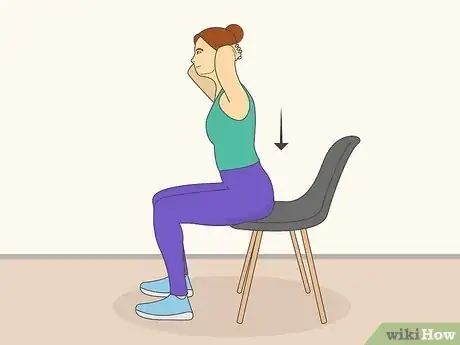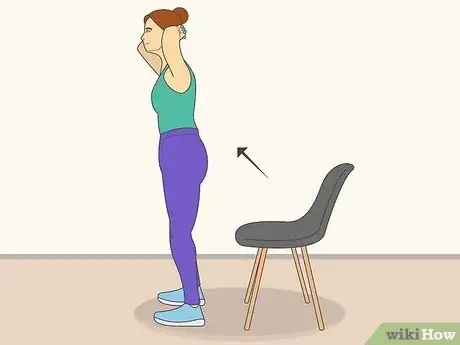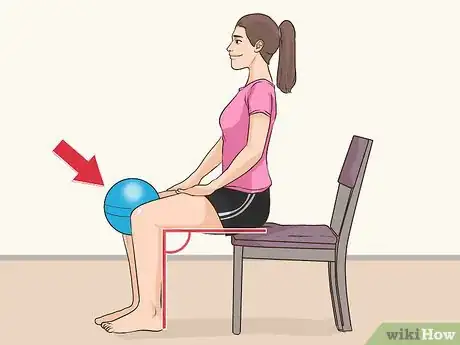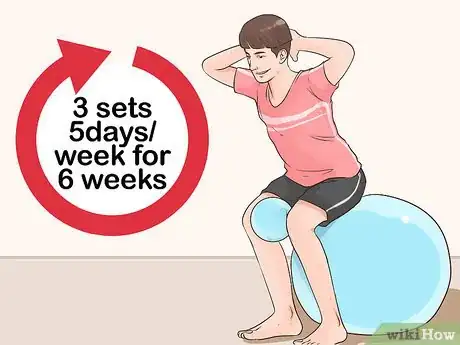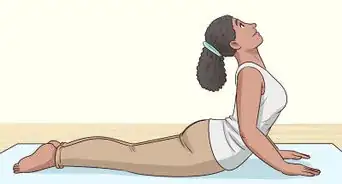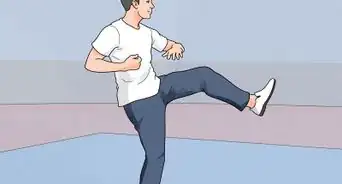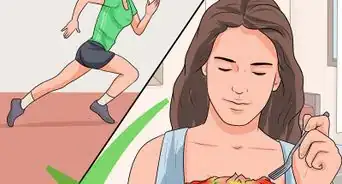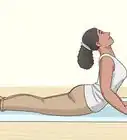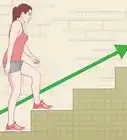This article was co-authored by Alphonso White. Alphonso White is a Certified Personal Trainer and Fitness Coach at CompleteBody in New York City. With over 20 years of experience in the personal fitness industry, Alphonso specializes in fat loss, toning, and functional training. As an ACE Certified Personal Trainer (ACE-CPT), he creates structured, personal workout plans geared towards short and long-term fitness goals. Alphonso also holds a BS in Nutrition and Exercise Science from Queens College and is a Black Belt in Seido Karate.
This article has been viewed 111,075 times.
Moving from sitting to standing is a motion that most people already do throughout the day. However, when this motion is done mindfully, it can be a gentle--yet effective--exercise. This movement can strengthen your legs, lower back, and core. It can be especially helpful for older folks and people recovering from lower back and hip injuries. The best part is that this is an exercise you can do just about anywhere. You can also make this a more vigorous exercise by adding weights, increasing the number of repetitions, or sitting on a stability ball.
Steps
Performing the Basic Move
-
1Sit down in a chair. Align your feet, knees, and hips so you're sitting up tall with a small arch in your lower back. Put your hands behind your head and clasp them together, like you're about to do sit-ups.[1]
-
2Stand without moving your feet. Engage your leg muscles and lift yourself in one fluid motion. Once you've risen to the point that your knees are straight but your back is still arched, lower yourself back down into your original position.[2]
- Try not to move your feet at all throughout.
- Keep your knees aligned directly above your ankles when you are sitting, and do not allow them to extend beyond your mid-foot as you stand.
Advertisement -
3Do 3 sets of 10 reps each. Lift and lower yourself 10 times, then take a little break. Repeat until you've completed 3 sets. For best results, do this series of movements 5 days a week. It may take up to 6 weeks of consistent practice for you to notice results.[3]
Doing Variations on the Exercise
-
1Place a small object between your legs. If your knees tend to collapse inward when you stand, you may need to encourage your glutes to engage more. Doing the sit-to-stand exercise with a small object between your legs can help with this. If you have a small exercise ball, or even a kid’s bouncy ball, this is ideal, but almost any small object can work. Press the ball (or other object) between your legs, and squeeze your legs together to keep the object in place as you stand.[4]
- You can try using a small pillow, yoga block, stuffed animal, or book.
-
2Sit on an exercise ball instead of a chair. This will throw off your balance, making it a little harder for you to rise up into a full standing position. Using a stability ball helps to strengthen your legs more effectively, and to better tone your core.[5]
-
3Increase the number of reps. For faster results, you can gradually increase the number of reps you do in each set. Try doing 3 sets of 15. If you’d still like more intensity, you can do 3 sets of 20. You can also increase the number of times you do this exercise per week.[6]
-
4Use dumbbells to add extra resistance. Another way to make this workout a little more intense is to hold a dumbbell in each of your hands[7] . Try starting with 3 pound (1.4 kg) weights. If that’s not enough, move up to 5 pounds (2.3 kg).[8]
- If you can get through 15-20 reps without feeling worn out, move up to slightly larger weights.
- As you continue to work out, move your weights up in 2 pound (0.91 kg) increments approximately every 8 weeks.
Expert Q&A
-
QuestionWhy should we do this?
 Michele DolanMichele Dolan is a BCRPA certified Personal Trainer in British Columbia. She has been a personal trainer and fitness instructor since 2002.
Michele DolanMichele Dolan is a BCRPA certified Personal Trainer in British Columbia. She has been a personal trainer and fitness instructor since 2002.
Certified Fitness Trainer This is a great exercise for building lower body strength and muscle, to keep our bones strong and healthy. It is very functional and as we age, people have a hard time doing this so practice it when you are able and develop the muscles and proper technique to make getting out of a chair easier as you get older.
This is a great exercise for building lower body strength and muscle, to keep our bones strong and healthy. It is very functional and as we age, people have a hard time doing this so practice it when you are able and develop the muscles and proper technique to make getting out of a chair easier as you get older. -
QuestionHow can I make a sitting-to-standing exercise more challenging?
 Alphonso WhiteAlphonso White is a Certified Personal Trainer and Fitness Coach at CompleteBody in New York City. With over 20 years of experience in the personal fitness industry, Alphonso specializes in fat loss, toning, and functional training. As an ACE Certified Personal Trainer (ACE-CPT), he creates structured, personal workout plans geared towards short and long-term fitness goals. Alphonso also holds a BS in Nutrition and Exercise Science from Queens College and is a Black Belt in Seido Karate.
Alphonso WhiteAlphonso White is a Certified Personal Trainer and Fitness Coach at CompleteBody in New York City. With over 20 years of experience in the personal fitness industry, Alphonso specializes in fat loss, toning, and functional training. As an ACE Certified Personal Trainer (ACE-CPT), he creates structured, personal workout plans geared towards short and long-term fitness goals. Alphonso also holds a BS in Nutrition and Exercise Science from Queens College and is a Black Belt in Seido Karate.
Certified Personal Trainer, CompleteBody NYC Adding dumbbells will increase the resistance. You can also pair it with another exercise, like arm curls or shoulder presses. Also, performing the exercise quicker will increase the intensity.
Adding dumbbells will increase the resistance. You can also pair it with another exercise, like arm curls or shoulder presses. Also, performing the exercise quicker will increase the intensity.
Things You Need
- Chair
- Small object
- Stability ball (optional)
- Dumbbells (optional)
References
- ↑ http://www.dummies.com/health/exercise/how-to-do-chair-squats/
- ↑ http://www.dummies.com/health/exercise/how-to-do-chair-squats/
- ↑ https://www.skimble.com/exercises/1074-chair-squats-how-to-do-exercise
- ↑ http://www.netfit.co.uk/fitness/exercises/abdominals/core-stability-exercises.htm
- ↑ https://greatist.com/fitness/workout-stability-ball-exercises
- ↑ https://www.skimble.com/exercises/1074-chair-squats-how-to-do-exercise
- ↑ Alphonso White. Certified Personal Trainer, CompleteBody NYC. Expert Interview. 24 February 2021.
- ↑ https://health.clevelandclinic.org/2016/07/tips-adding-resistance-training-workout/
